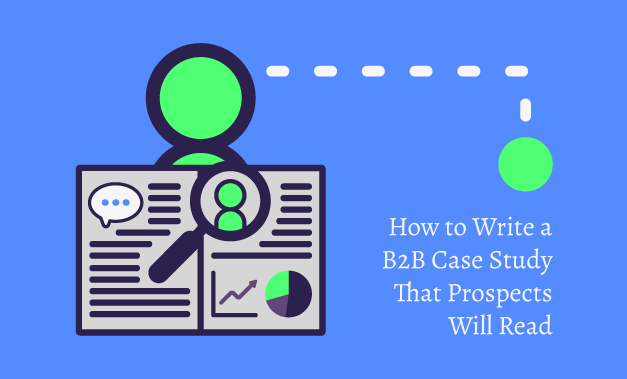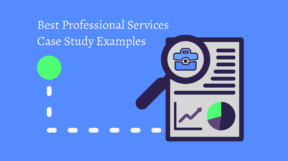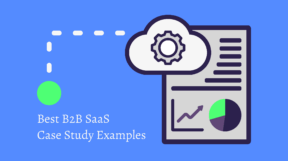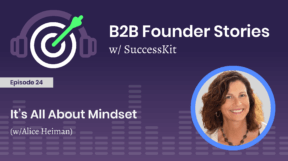A B2B Case Study is a valuable marketing tool. As such, your Case Study should be written to communicate the success your client or customer has experienced with your product or service. It’s the complete story of how your product or service solved a client’s or customer’s problem, as well as the ensuing results or benefits.
It’s helpful to think of your B2B Case Study as a long-form testimonial. A testimonial is a short statement extolling the virtue of a product or service. It’s a form of social proof that inspires faith that your product or service does what you say it will do一and does it well.
If you’re reading this, it’s because you want to write a B2B Case Study for your business. It’s a challenging document to produce, but it’s well worth your time.
Here’s how to tackle your first B2B Case Study in five steps.
Step 1: Select the Featured Client or Customer for Your B2B Case Study
The first thing to do is select the client or customer you will feature in the B2B Case Study. Be sure to pick a client that has had outstanding success using your product or service. For instance, select a company that has realized huge revenue gains or saved lots of money. The more significant your product’s or service’s impact on the featured client, the more powerful your B2B Case Study will be.
Where do you find the best clients or customers to feature? Ask your sales team or any customer-facing employees. They should know first-hand which company has had tremendous success with your product or service.
Just because some clients or customers initially look like good candidates for a Case Study, it’s a great idea to pre-qualify them. Consider asking your potential candidates a few questions to make sure you’re clear that their stories are compelling and that they have experienced amazing results or several excellent benefits.
Step 2: Interview the Featured Client or Customer
The information you collect during the interview creates the meat for your B2B Case Study. Based on your knowledge of your product or service and your client or customer, draft a comprehensive list of questions designed to elicit detailed information about your client or customer’s experience and success. Remember that every business is different, so you must tailor your questions to each company representative that you interview.
Also, when you’re formulating your list of questions, consider the angle of the B2B Case Study. For example, in one B2B Case Study, you may want to focus on ease of use. In another, you may want to focus on the generated revenue. Regardless of the angle you choose, try hard to get measurable results. But remember not to overlook qualitative results.
Be sure to record the interview instead of trying to take notes, and consider getting a transcript of the recorded interview. You’ll find that it’s easier to write the B2B Case Study when the featured client’s actual words are your source material.
Step 3: Draft the B2B Case Study
Drafting the B2B Case Study is the most challenging part of the process. Not only do you need to use the proper structure, but you also need to make the Case Study compelling.
First, think about the structure. Most of the Case Study examples you will find with a simple Internet search will follow the Problem/Solution/Results structure. Depending on the specific story, you may opt for the Situation/Solution/Benefits structure. These are well-established ways to write a Case Study that’s easy to read and even easier to skim.
Select the first structure (Problem/Solution/Results) when there is an identifiable problem. For instance, your featured client or customer may have a problem due to using multiple computer systems that don’t talk to each other. Here, you present the problem that existed before you introduced your solution. Then you describe the solution and how it is applied. Finally, you discuss or list the results your featured client or customer experienced.
Select the second structure (Situation/Solution/Benefits) when there is no identifiable problem. For instance, your featured client or customer may be outgrowing its existing computer network. Following this format, discuss the situation that your client or customer was in before you introduced your solution. Then describe the solution. Finally, discuss the benefits your solution brought into being.
Whichever structure you choose, keep the text to two pages or less. Few prospects will read the entire Case Study if it’s longer than that.
Step 4: Design the B2B Case Study
Don’t underestimate the persuasiveness of a well-designed B2B Case Study. Having only text on a page is the kiss of death. Even you wouldn’t want to read that document!
Make the Case Study colorful and attractive. Follow your design guidelines if you have them. Or use the colors that are on your website to align the design with your brand.
Wherever possible, use images, charts, or other graphics. Not only do they add flavor to the B2B Case Study, but they also communicate information in an easy-to-read format.
Additionally, consider using quotes from the featured client or customer. It’s one thing to write that your clients said something, but it’s quite another to use their actual words in praise of your product or service.
Again, limit the final design to just two pages.
Step 5: Get Approval from the Featured Client or Customer
Never publish or distribute a B2B Case Study before getting explicit approval from the featured client or customer in an email or letter. You want the approval on the record. If you have written a Case Study that’s true to what the client or customer told you during the interview, getting approval for publishing or distributing the Case Study will be easy.
Start by sending the completed Case Study to the featured clients or customers and ask them to review it and suggest any edits they may want to see. Why send the completed Case Study? You’ll find that they will make fewer edits if the Case Study is in its completed form.
What’s Next?
Now that you know how to craft a Case Study, it’s time to create another one. Why? Because just like it’s always better to have multiple testimonials, it’s better to have multiple Case Studies.
To gain inspiration to write your next Case Study, think about all of the vertical markets that you serve. You know that you have vertical markets when you offer products or services to specific industries, professionals, or other groups of customers.
Even if you only serve one target market, multiple Case Studies have the effect of causing the reader to feel comfortable purchasing your product or service. Think about how Amazon sellers leverage ratings and testimonials. If you’ve ever shopped on Amazon, those two things have probably impacted your purchasing decision either positively or negatively.
So, now that you know the value of Case Studies and how to write them, it’s time to get started.
Conclusion
Here at Successkit, we know that writing a compelling B2B Case Study一one that prospects will read一can be difficult to produce. That’s why we handle the entire process from beginning to end. The only thing you need to do is the first step of selecting your featured client. We’ll take care of the rest. If you need help creating your collection of Case Studies, reach out to the customer service team at [email protected].




























































